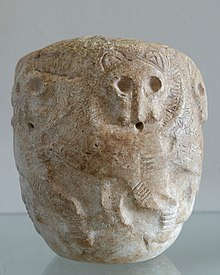Mesilim

Mesilim , also Mesalim , (around 2600/2400 BC). was a king of the third dynasty of Kiš . However, he is not mentioned in the Sumerian king list . Through many votive offerings and temple buildings that bear his name, especially from Girsu, Lagash and Adab, he was the first king to become known in the exploration of the ancient Orient .
For dating
Unfortunately, the Mesilim's reign cannot be precisely determined and depending on the author and chronology, his reign may vary. So you can only approach the date relatively. We know that Mesilim ruled before Ur-Nanše because he was also the ruler of Lugalshagengur in Lagash , and that he settled the border dispute between Lagash and Umma . This arbitration lasted until Ush and Eannatum , great-grandson of Ur-Nanshe, once again took the borders as an issue of dispute.
The Lagash-Umma Border Conflict
Mesilim is best known in history for his role as mediator in the conflict between Lugalshaengur, ensi in Lagash and its neighbor in neighboring Umma over irrigation rights in the border area between the two. After asking for the opinion of his god Ištaran , city god of Der , Mesilim established a new border between Lagash and Umma and erected a stele to mark it. His role as a mediator between divided parties indicates his high position within the various city-states and shows that Mesilim held a high position despite his later obscurity. The famous vulture stele describes precisely this conflict . However, it is not certain whether this stele is the Mesilim stele or one of several copies that marked the border.
Origin from the
A theory by Jerrold S. Cooper about his origins says that he was originally a primordial opator from the city of Der, accordingly he calls upon the god Ishtaran, the city god of the city of Der, for assistance during an arbitration. In addition, it would explain the fact why he was not included in Kisch's list of kings. However, this idea could not fully prevail, as further evidence is missing.
Mesilim style
In German literature there was the so-called Mesilim period, or the Mesilim style in art. The Mesilim style is characterized by a simplified representation of the glyptic. The animals and people are woven into endless chains on the cylinder seals and the animals are placed on their back legs. The so-called animal friezes or figure bands are created. Very abstract cylinder seals made of rhombuses and triangles are also becoming fashionable.
In the round sculpture, elongated bodies with filigree limbs dominate the picture. A special feature are the oversized eyes of the so-called praying figures and the enraptured, almost transcendent facial expression of these.
Are Mesilim and Messanepada identical?
Since Mesilim appears to have been quite an influential king, it is strange that he does not appear on the Sumerian royal list. Hence Edmund Gorden came up with the idea that Mesilim could be King Messanepada of Ur from the Sumerian king list. His reasoning was based on an inscription that exists in a Sumerian and Akkadian version. Once the Sumerian inscription says:
"Ebabbar, the temple built by Mesilim, was destroyed by Annane, whose seed has been torn off."
In a school text from Sippar from the late Babylonian period it says in Akkadian:
"The temple that Messanepada built was destroyed by Nanna, whose seed has been torn off."
Since Nanna is a nickname of the name Annane and Annane was a descendant of Messanepada, he now assumed that Mesilim itself could be another spelling for Messanepada.
Thorkild Jacobsen contradicted this, among other things, by pointing out that the late Babylonian writing student lacked the Akkadian spelling of the name Mesilim, since this was not on the Sumerian king list either and he therefore took the one he could translate and was also the ancestor of the second named Annane , and so replaced the name Mesilim with Messanepada. To date, no further connection between Mesilium and Messanepada has emerged, which is why Edmund Gorden's thesis is viewed as refuted.
See also
Remarks
- ^ A b Leick, Gwendolyn: Who's who in the ancient Near East . Routledge, London 2002, ISBN 978-0-415-13231-2 .
- ↑ a b c d Dietz O. Edzard: Mesilim in: Reallexikon der Assyriologie und Vorderasiatischen Aräologie . tape 8 . Leipzig 1993.
- ^ Cooper, Jerrold S .: Reconstructing history from ancient inscriptions: the Lagash-Umma border conflict . Undena Publications, Malibu 1983, ISBN 978-0-89003-059-2 .
- ^ Dietz O. Edzard: Mesilim B in Reallexikon der Assyriologie und Vorderasiatischen Aräologie . tape 8 . Leipzig 1993.
- ^ Edmund I. Gordon: Mesilim and Mesannepadda: Are They Identical? Bulletin of the American Schools of Oriental Research No. 132 (Dec. 1953), pp. 27-30
- ↑ Thorkild Jacobsen: EarlyPolitical Development in Mesopotamia in: Toward the image of Tammuz . Harvard University Press, Cambridge 1970, ISBN 978-0-674-89810-3 .
| personal data | |
|---|---|
| SURNAME | Mesilim |
| ALTERNATIVE NAMES | Mesalim |
| BRIEF DESCRIPTION | early dynastic king of Kiš |
| DATE OF BIRTH | around 25th century BC Chr. |
| DATE OF DEATH | around 25th century BC Chr. |
